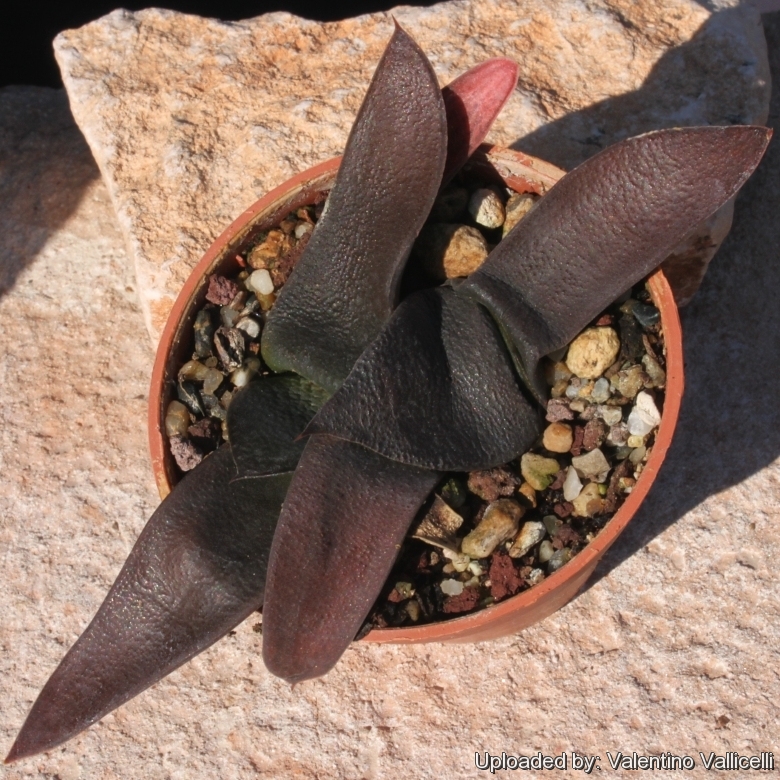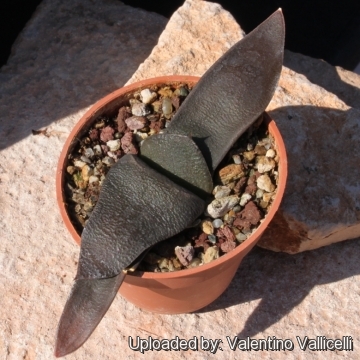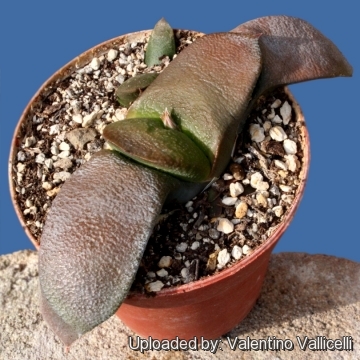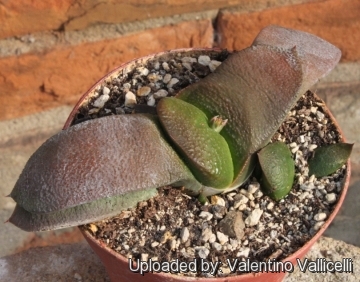Accepted Scientific Name: Gasteria nitida var. armstrongii (Schönland) van Jaarsv.
Aloe 29(1): 12, 28 (1992)

Gasteria nitida var. armstrongii (Long leaved form) Photo by: Valentino Vallicelli
Origin and Habitat: Garden origin (Nursery produced cultivar)
Synonyms:
See all synonyms of Gasteria nitida
back
Accepted name in llifle Database:Gasteria nitida (Salm-Dyck) Haw.Philos. Mag. Ann. Chem. 2: 358 1827.Synonymy: 25
Accepted name in llifle Database:Gasteria nitida var. armstrongii (Schönland) van Jaarsv.Aloe 29(1): 12, 28 (1992)Synonymy: 6
back
Description: Tongue shaped, Gasteria nitida var. armstrongiiSN|1475]]SN|1475]] (long leaved form) is a slim-leafed variety (or hybrid) distinguished from the standard species for its unusual long leaves. There are several clones in cultivation with leaves ranging from small to broad and more or less long.
Remarks: Gasteria nitida var. armstrongiiSN|1475]]SN|1475]] has been widely selected and hybridized and nowadays many clones are available most of which were developed in Japan.
Habit: It is a distinctive neotenic miniature succulent with short, rounded and thick distichous rosettes of two to four leaves up to 10 in diameter. Old specimens cluster naturally with new plants around the original. It is very slow growing.
Stem: Acaulescent.
Roots: Thick, fusiform and succulent up to 12 mm in diameter, with little branching, and endowed with the ability to contract, physically pulling the plant down into the ground during dry weather.
Leaves: Distichous (grow in two planes only), dark green to nearly black that can take maroon-red colouring in full sun, very strong, compact and thick that lie flat to the ground and have a rough, bumpy, tongue-like appearance. Sometimes with prominent paler tubercles or warts that may develop with age. Tip somewhat retuse, obtuse or truncate. Margin entire or slightly tuberculate. Often the leave has a deep V-shaped proximal depression.
Flower: The inflorescences are smaller up to 50 cm tall and unbranched but bear 20 mm long flowers. Flowers 20-25 mm long, pinkish-red, stomach-shaped for about half of the perianth length. Perianth tips yellowish-green.
Blooming season: Summer.
Fruits: Oblong about 25 x 8 mm wide.
Subspecies, varieties, forms and cultivars of plants belonging to the Gasteria nitida group
Bibliography: Major references and further lectures
1) Van Jaarsveld, E.J. “Gasterias of South Africa.” Fernwood Press. 1994
2) Urs Eggli “Illustrated Handbook of Succulent Plants: Monocotyledons” Springer, 2001
3) Stuart Max Walters “The European Garden Flora: Pteridophyta, Gymbospermae, Angiospermae-Monocotyledons” Cambridge University Press, 1984
4) Mucina, L. & Rutherford, M.C. (eds) 2006. “The vegetation of South Africa, Lesotho and Swaziland.” Strelitzia 19. South African National Biodiversity Institute, Pretoria.
5) Van Jaarsveld, E.J. “The genus Gasteria, a synoptic review.” in: Aloe 44: 4: 84–103 2007
6) Ernst Van Jaarsveld, Ben-Erik Van Wyk, Gideon Smith “Succulents of South Africa: A Guide to the Regional Diversity” Tafelberg Publishers, Limited, 01/lug/2000
 Gasteria nitida var. armstrongii (Long leaved form) Photo by: Valentino Vallicelli
Gasteria nitida var. armstrongii (Long leaved form) Photo by: Valentino Vallicelli Gasteria nitida var. armstrongii (Long leaved form) Photo by: Valentino Vallicelli
Gasteria nitida var. armstrongii (Long leaved form) Photo by: Valentino Vallicelli Gasteria nitida var. armstrongii (Long leaved form) Photo by: Valentino Vallicelli
Gasteria nitida var. armstrongii (Long leaved form) Photo by: Valentino VallicelliSend a photo of this plant.The gallery now contains thousands of pictures, however it is possible to do even more. We are, of course, seeking photos of species not yet shown in the gallery but not only that, we are also looking for better pictures than those already present.
Read More... Cultivation and Propagation: Gasteria armstrongiiSN|1474]]SN|1474]] is of easy culture which makes it a good houseplant and can be an excellent subject for the beginning gasteriaphile (it can grow easily on window sills, verandas and in miniature succulent gardens where they are happy to share their habitat with other smaller succulent plants, or in outdoor rockeries)
Growth rate: It is a slow growing but long-lived plant that offsets to form small clusters with time.
Soil: It is tolerant of a wide range of soils and habitats, but prefers a very porous potting mix to increase drainage. A non-acid soil is ideal. You can grow a plant in a 10-15 cm pot for years and have perfectly happy plants. For best results, use a shallow pot.
Exposure: Need light shade to shade, but will take full sun part of the day. (with some sun exposure the leaf develops a nice reddish tint and remain compact) During the hot summer months, the soil should be kept moist but not overly wet.
Watering: During the hot summer months, the soil should be kept moist but not overly wet. During the winter months, water only when the soil becomes completely dry. Wet soil quickly causes root and stem rot, especially during chilly winter months. No water should ever be allowed to stand around the roots. Low ambient humidity is always needed.
Feeding: The plants are fertilized only once during the growing season with a balanced fertilizer diluted to ½ the recommended strength.
Hardiness: During the winter months, water only when the soil becomes completely dry. Frost hardy to -1°C (Or less). Gasteria armstrongiiSN|1474]]SN|1474]] is among the rather limited number of plants which can hold their own in overheated apartments and homes.
Pest and diseases: Rot is only a minor problem with Gasteria if the plants are watered and “aired” correctly. If they are not, fungicides won't help all that much. Incorrect watering, poor drainage or too much shade can lead to attack by pests and diseases. Care must be given in watering, keeping them warm and wet while growing, and cooler and dry when dormant.
Remarks: Gasterias are best planted in a shaded and airy part of the greenhouse, and not too close to the glass roof or sides of the house as the plants can overheat during hot spells.
Propagation: Gasterias are easily propagated by the removal of offshoots or by leaf cuttings in spring or summer. To propagate by leaf cuttings, remove a leaf and let it lie for about one month, giving the wound time to heal. Then lay the leaf on its side with the basal part buried in the soil. This leaf should root within a month or two, and small plants will form at the leaf base. They can also grown from seed.













